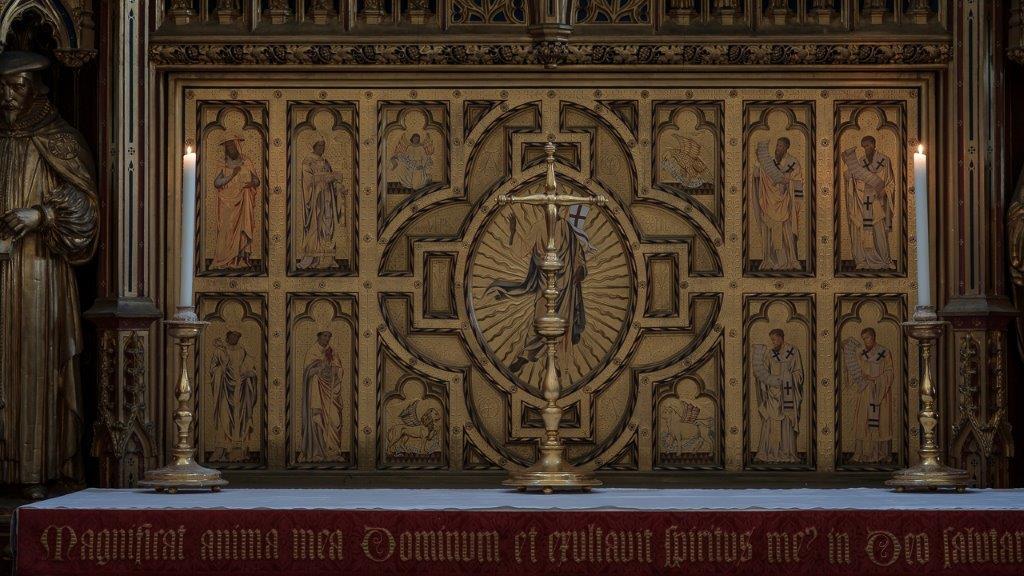The Great Screen is one of the treasures of the Cathedral
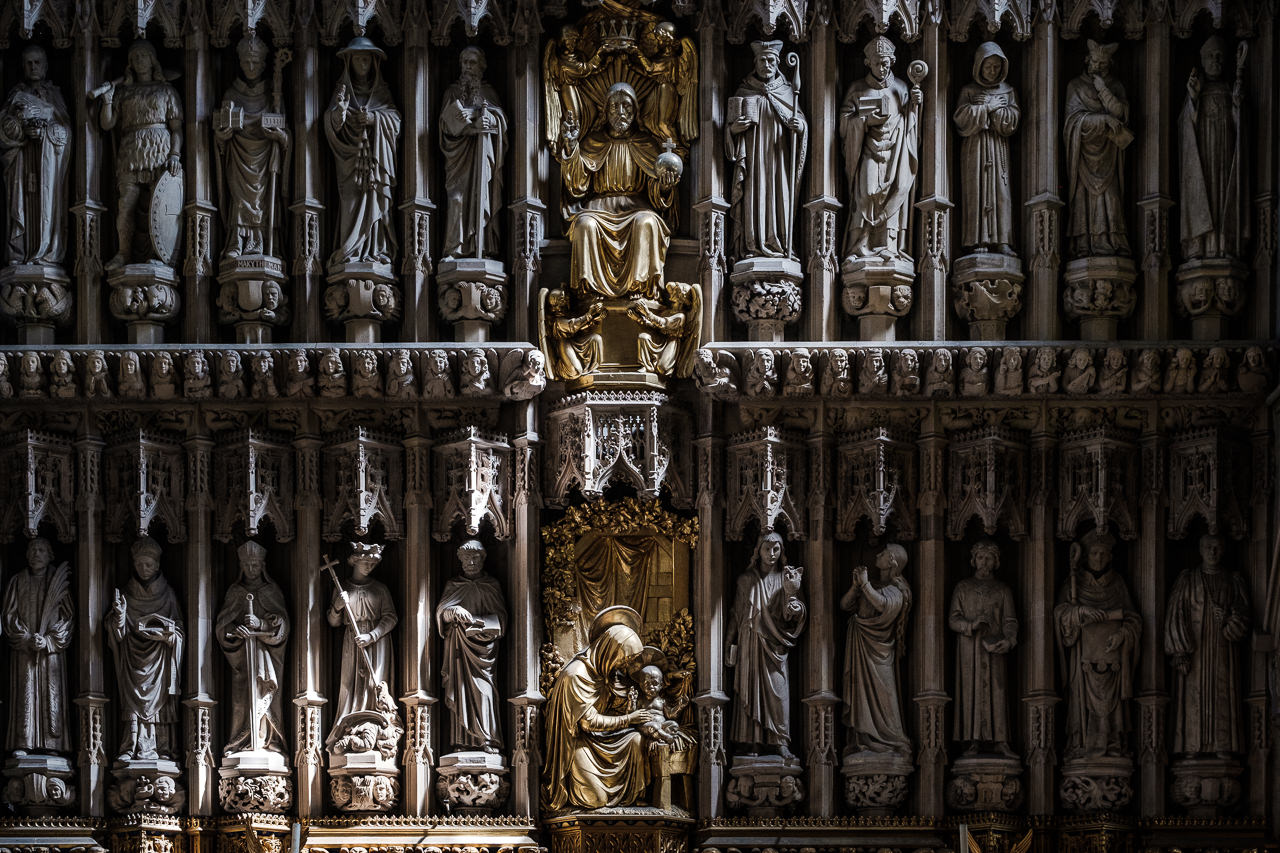
Our magnificent screen was erected by Bishop Fox of Winchester in 1520. Although the general appearance of the screen, with three broad rich bands of carvings, is that of the original, most of the detail is from later periods. Whether all the original statues were ever installed is uncertain, as the screen was completed within a decade of the Reformation when such statues were forbidden. The small carvings of the Lamb of God and the pelican (a badge of Bishop Fox) immediately above the rows of angels are probably original, as are some of the bases of the niches. The small carvings in the corners of the two doorways, showing hunting scenes, may also be original.
In 1703, the Great Screen was concealed by a painted wooden screen on which were inscribed the Lord's Prayer, Creed, the Ten Commandments, a dove descending with a group of cherubs heads topped with flaming urns.
This wooden screen was removed in 1830, and the niches restored and three rows of carved angels added.
In 1930, the lower portion was gilded and a new panel showing the Greek and Latin Fathers of the Church was added. This was inspired by a panel in St Mark's, Venice. The central figures of Christ in Majesty (St Saviour) and the Blessed Virgin Mary with the Christ Child (St Mary Overie) were gilded in the 1970s.
The majority of the figures set in the screen were carved by Messrs Nicolls of Lambeth from 1905 onwards. They tell the story of the church in which they stand.
Upper row from left to right
Bishop Anthony Wilson Thorold (1825 –1895)
Thorold was the Bishop of Winchester in the late-Victorian era and therefore responsible for the fate of St Saviour's, Southwark (the building we know as Southwark Cathedral). In 1877 he was made Bishop of Rochester, the same year that the church was moved to the Diocese of Rochester.
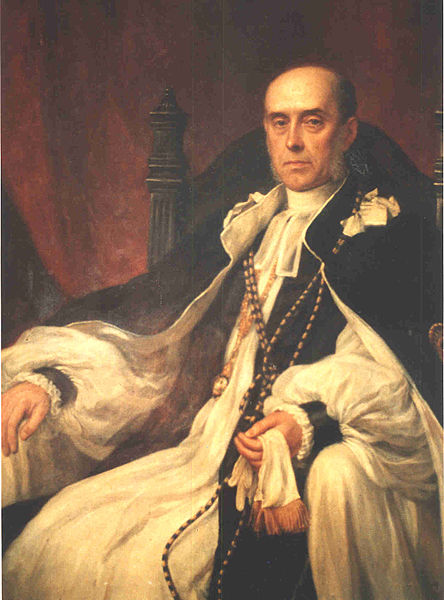 In his role as bishop, Thorold recognised that there was the need to replace the nave which was at a different level from the rest of the church; he led the subscription of funds for the new nave, putting much of his own money towards the restoration. The new nave was designed by Sir Arthur Blomfield and built by a local builder, Thomas Rider.
In his role as bishop, Thorold recognised that there was the need to replace the nave which was at a different level from the rest of the church; he led the subscription of funds for the new nave, putting much of his own money towards the restoration. The new nave was designed by Sir Arthur Blomfield and built by a local builder, Thomas Rider.
Thorold also identified that a separate Diocese was needed in the area surrounding St Saviour's; the church was the obvious choice for a new Cathedral because of its size, long history and central location. In 1896, St Saviour’s became the Pro-Cathedral of South London and in 1905 Parliament passed an Act making Southwark a new Diocese.
During Thorold’s time as bishop, he wrote a number of devotional works, but his biggest impact on the Church of England was his recruitment of Isabella Gilmore to revive the female diaconate in the Order of Deaconesses, whose training house was in Clapham and whose role would be “a curiously effective combination of nurse, social worker and amateur policeman”.
Saint Olave (995 – 1030)
St Olave (Olav or Olaf), a Norseman, was King of Norway, and is credited with converting Norway to Christianity. He was canonized by his chief bishop, Grimketel, in 1030; this was recognized in 1164 by Pope Alexander III and meant he was universally regarded as a saint by the Roman Catholic Church.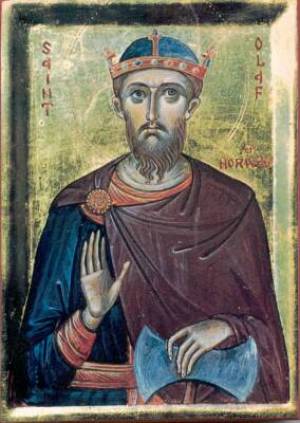
In his life time, he was known as 'Olaf the Stout’ and as a youth had led a raid on London pulling down London Bridge and restoring the throne to King Ethelred the Unready. Apart from this story connecting Olaf to Southwark, there was also a church by London Bridge dedicated to St Olave. Written evidence of the existence of this church can be found as far back at 1096 when there is a reference to ‘Peter de St Olavo’ being involved in a land transaction with Bermondsey Priory. It is thought that Grimketel’s move from Norway to England and his role as Bishop of Selsey are the reason for the number of St Olave church dedications in England.
He can be seen in the screen holding the axe and shield of a viking.
Although St Olave’s church disappeared in the 1920s, it had already given its name to Tooley Street; older maps noted the church as "Synt Toulus", "Toulas", "Toolis", and "Toolies". The old bell turret from the 1728 church can be found at Tanner Street Park, Bermondsey where it has been redesigned as a water fountain.
William Wykeham, Bishop of Winchester (1324 – 1404)
William Wykeham is best known for founding New College Oxford in 1379 and Winchester College in 1382. His connection to Southwark Cathedral is through his role as Bishop of Winchester, when from 1366 he was responsible for St Mary Overie Priory (the old name of Southwark Cathedral) in the Diocese of Winchester.
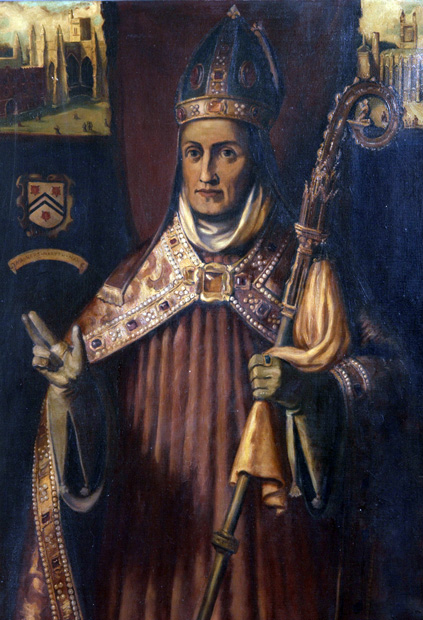 In 1390, he sent Simon, Bishop of Achonry, to reconcile the church of St Mary Overie and the annexed church of St Mary Magdalen and to dedicate the altars and graveyard. In 1397, after a personal visit in 1395, he sent his staff to visit the priory. The prior John Kyngeston was in very bad health and unable to rule the house. Custody was pasted over to the sub-prior with the full power of punishing excesses and delinquencies. No canon was allowed to leave the place except under exceptional circumstances on pain of imprisonment.
In 1390, he sent Simon, Bishop of Achonry, to reconcile the church of St Mary Overie and the annexed church of St Mary Magdalen and to dedicate the altars and graveyard. In 1397, after a personal visit in 1395, he sent his staff to visit the priory. The prior John Kyngeston was in very bad health and unable to rule the house. Custody was pasted over to the sub-prior with the full power of punishing excesses and delinquencies. No canon was allowed to leave the place except under exceptional circumstances on pain of imprisonment.
Wykeham’s attitude to money played a role in his relationship with the priory. In 1399, he reprimanded the prior at St Mary’s Overie who had decided that the priory could not benefit from funds from taverns or any illicit trades that might discredit the church; Wykeham felt that the priory wasn’t getting all the money owed to it. When Wykeham died in 1404, he was one of the richest men in England.
He is seen in the screen holding models of Winchester Cathedral and Winchester Palace, Southwark. The figure was donated by Dr A.B. Stevens in order to show the relationship which existed between Southwark and the Diocese of Winchester.
Cardinal Henry Beaufort, Bishop of Winchester (1375 – 1447)
Henry Beaufort became Bishop of Winchester in 1404 which meant that the priory of St Mary Overie (the old name for Southwark Cathedral) became his responsibility. During his time as bishop, Beaufort commissioned Henry Yevele to extensively repair the priory building; this included the south transept where his coat of arms, surmounted by his hat, can be seen on the vaulting shaft.
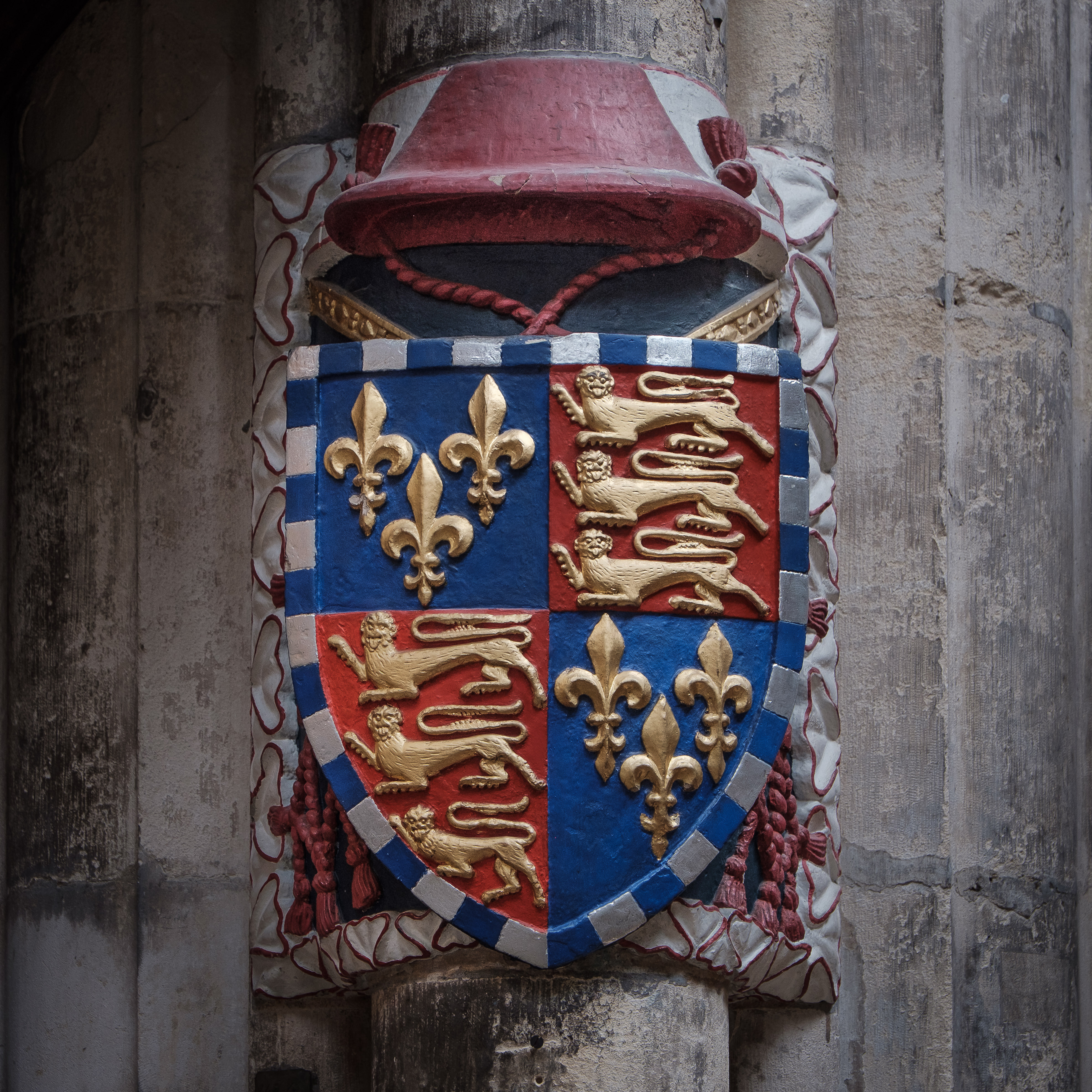
Beaufort, being related to royalty (but barred from succession as his mother had initially been a mistress) was closely involved with government. When his half-brother Henry of Bolingbroke (Henry IV) worked his way onto the throne, Beaufort became Lord Chancellor. Beaufort and his siblings, although denied certain royal rights, were still privileged and powerful enough to marry those in power; in 1424, Joan, the daughter of Beaufort’s eldest brother, married King James I of Scotland in St Mary Overie. This was the only royal wedding that that has taken place in the church we now know as Southwark Cathedral. The wedding feast was held at nearby Winchester Palace and the couple went back to Scotland where they were both crowned King and Queen at Scone Abbey.
Beaufort also appears in a couple of Shakespeare’s plays: Henry IV parts 1 and 2. He is portrayed in a negative light and involved in bribery and murder plots. Historians, both contemporary and at the time, have judged Beaufort as greedy and deceitful, but he was also considered to be one of the wealthiest and most successful men of that time.
Saint Paul
Saint Paul is considered to be one of the most important figures in Christianity. Of the books in the New Testament, just under a half are attributed to him, with the book of The Acts of the Apostles largely being an account of his ministry.
His startling transformation from Saul, an early persecutor of Christians, to Paul, a leading figure in the foundation of Christianity, is recounted as the Road-to-Damascus story, when Paul had an encounter with the Risen Jesus which led to his conversion to Christianity and his Baptism.
Paul established churches throughout the Roman Empire and his Epistles, as collected in the New Testament, became the foundation of subsequent Christian theology. His presence in the screen at Southwark Cathedral recognises his importance in the history of church and Christian faith and also his place as one of the Patrons of the Diocese of Winchester. His symbol, the sword, is intertwined with the symbol of the other patron, St Peter.
Christ the Saviour
Christ the Saviour is the central figure in the screen at Southwark Cathedral. Not only does it reflect the central role that Christ plays in the church but also reflects the name that the church carried after the closing of the monasteries by Henry VIII when the Priory Church of St Mary Overie became the parish church of St Saviour, Southwark.
Saint Augustine of Hippo (354 – 430)
Augustine was an early Christian theologian and philosopher whose writings influenced the development of Western Christianity and Western philosophy. Born in Roman Africa to Christian parents, he was well educated and spent much of his time as a young man living a hedonistic life. Augustine initially chose to follow a different religion from his parents, but at age 31 he converted to Christianity. Inheriting his parents' house, he transformed it into a monastic foundation.
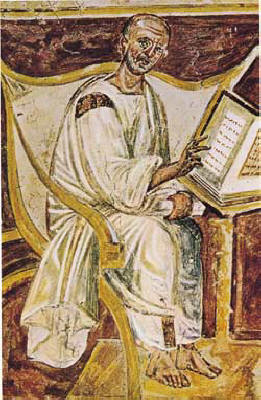 In 391 Augustine was ordained a priest. He became a famous preacher, and in 395 he became the Bishop of Hippo where he spent much of his life attempting to convert the people of Hippo to Christianity. Augustine was considered a great intellect and powerful orator. His personal traits were described by a contemporary called Possidius, who said Augustine ate sparingly, worked hard, disliked gossip, shunned temptations of the flesh and was sensible in managing the finance of his See.
In 391 Augustine was ordained a priest. He became a famous preacher, and in 395 he became the Bishop of Hippo where he spent much of his life attempting to convert the people of Hippo to Christianity. Augustine was considered a great intellect and powerful orator. His personal traits were described by a contemporary called Possidius, who said Augustine ate sparingly, worked hard, disliked gossip, shunned temptations of the flesh and was sensible in managing the finance of his See.
After his death, Augustine was canonised; he is considered to be the patron saint of brewers, printers, theologians, and sore eyes. When the church we now know as Southwark Cathedral was originally established in 1106 as a priory, it was created as a base for the Canons Regular of St Augustine of Hippo (Augustinians).
He holds in his hands a copy of his Confessions.
William Giffard (? - 1129)
It is believed that it was William of Giffard who supported two Norman knights, William Dauncey and William d’Arche to build a Priory as a base for the Canons Regular of St Augustine of Hippo (Augustinians) at the site we now know as Southwark Cathedral. This was in 1107.
Before this time, Giffard had filled the office of Chancellor to William the Conqueror and his son William Rufus. It is said that Giffard was part of the hunting party on the day when William Rufus was killed in mysterious circumstances. Henry I, who swiftly laid claim to the throne, offered the Diocese of Winchester to Giffard although he initially declined it. Building up a strong relationship with Archbishop Anselm of Canterbury, he was eventually consecrated as Bishop of Winchester.

One particularly notable achievement of Giffard was to offer the first home in England to the monks of the Cistercian Order; he helped to establish the abbey of Waverley near Farnham, Surrey in 1128. Within Southwark, not only did he settle the priory but he established the London base of the Winchester bishops which played such a big role in the lives of the residents of Southwark.
Aldgood (? – 1130)
Aldgood was the first prior at the priory built by two Norman knights, William Dauncey and William d’Arche as a base for the Canons Regular of St Augustine of Hippo (Augustinians) at the site we now know as Southwark Cathedral.
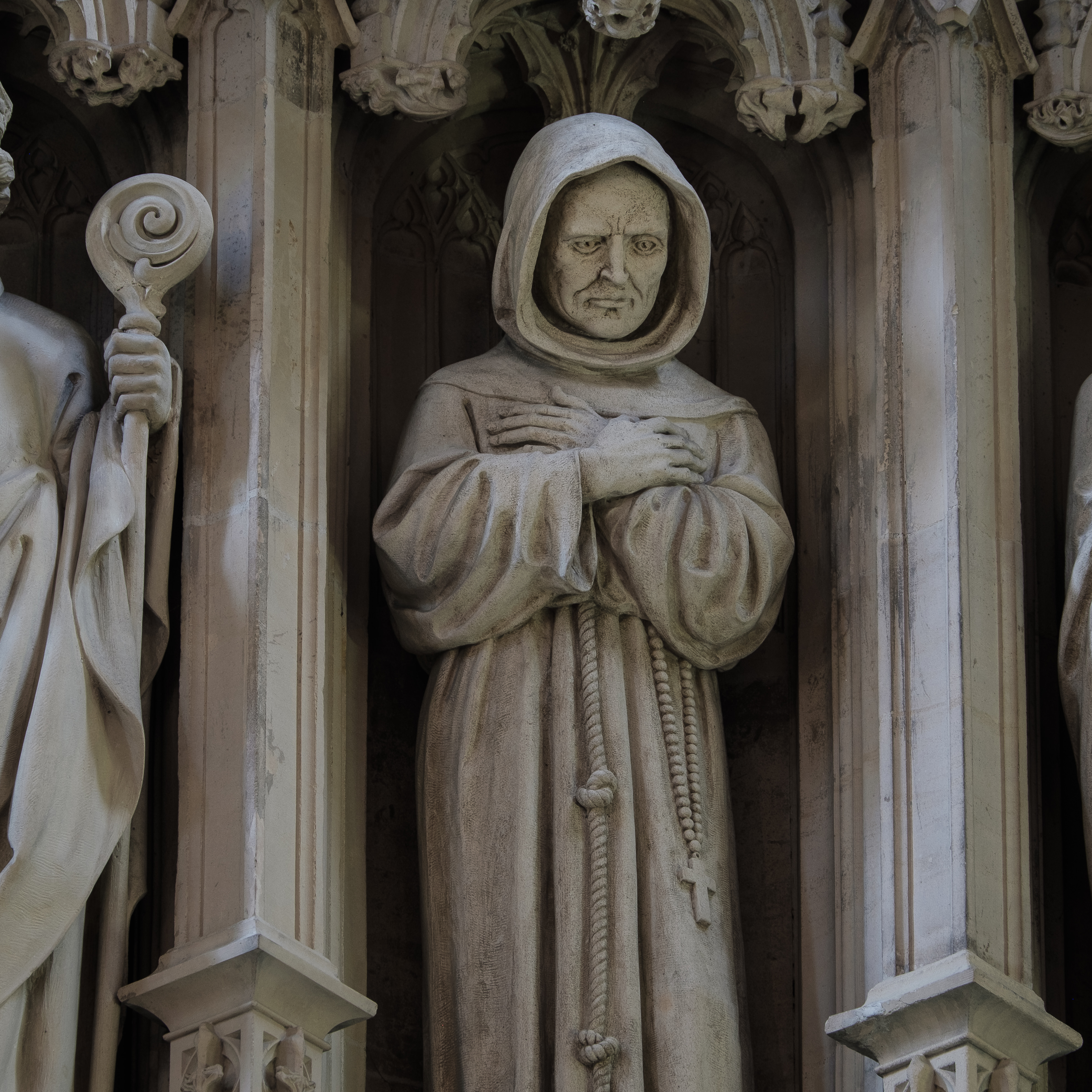 There is no information about Aldgood, where he was from, and how he came to this position. However, there is information about the lifestyle of those who followed the rule of St Augustine. Known as Augustinians, they were not only responsible for offering worship but the rule by which they lived stated that they must give relief to the sick and needy. They were instructed to always maintain ‘a stock of socks, linen and woollen clothes ...so that if Christ himself should at some time appear in the guise of a naked or poor man. His need not go empty without a gift’.
There is no information about Aldgood, where he was from, and how he came to this position. However, there is information about the lifestyle of those who followed the rule of St Augustine. Known as Augustinians, they were not only responsible for offering worship but the rule by which they lived stated that they must give relief to the sick and needy. They were instructed to always maintain ‘a stock of socks, linen and woollen clothes ...so that if Christ himself should at some time appear in the guise of a naked or poor man. His need not go empty without a gift’.
Saint Justus (? – 631)
Justus was a missionary sent to England by Pope Gregory in 601 on a mission to convert the Anglo-Saxons. Augustine of Canterbury consecrated Justus as the first Bishop of Rochester in 604. During this period, Southwark was part of the Diocese of Rochester and so any religious settlement on the site of Southwark Cathedral would have been overseen by the Bishop of Rochester. 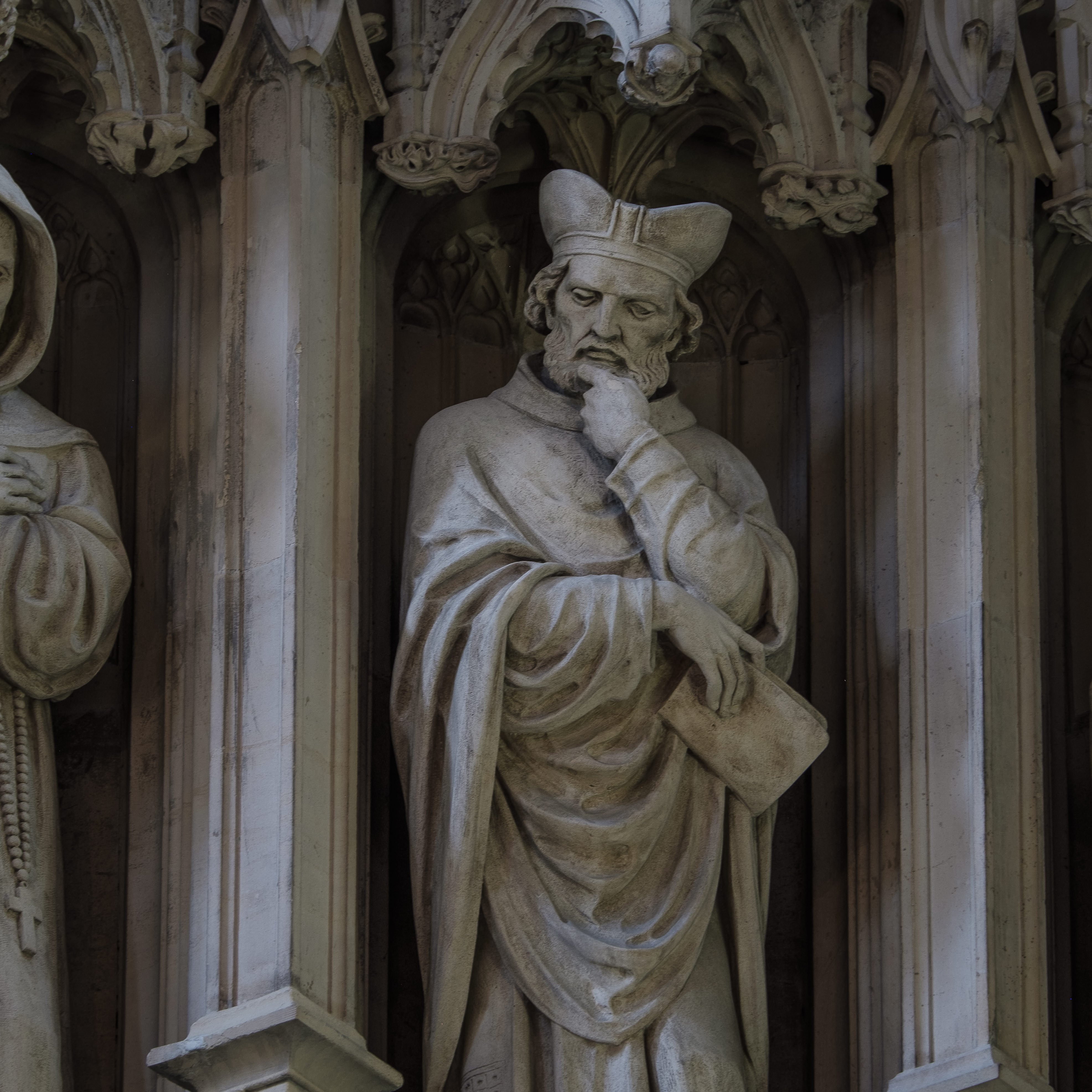
King Aethelberht built Justus a cathedral church at Rochester, but after the king’s death there was a backlash against Christianity and Justus was chased out of the country. Eventually Justus was welcomed back and in 624 he became the Archbishop of Canterbury. After his death, Justus was regarded a saint and his feast day is on the 10th November.
Justus’ story is mainly extracted from Bede’s Ecclesiastical History of the English People written in the 8th century.
He is commemorated in the screen in order to recall the relationship between the Rochester Diocese and our own.
Bishop Edward Talbot (1864 – 1948)
Talbot spent his early career as a history tutor, having graduated from Christ Church, Oxford. In 1869, he was appointed first warden of Keble College and in 1878 he worked with his wife to set up Lady Margaret Hall, the first college for women in Oxford.
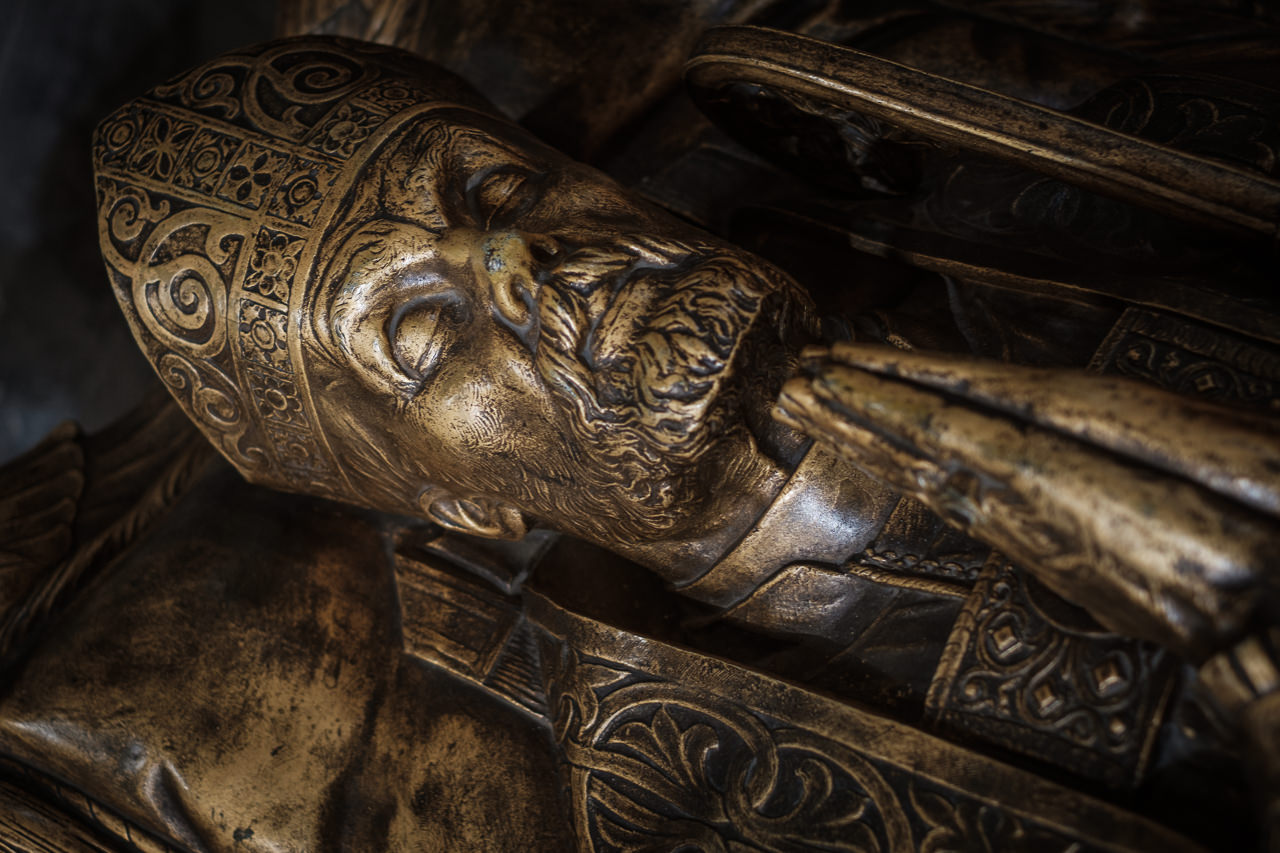 Talbot also spent time involved in the Settlement Movement which was the concept of educated people living and working amongst the less fortunate of society. Having decided that Toynbee Hall in East London was not sufficiently religious, he decided to create a ‘more ascetic, denominationally religious settlement’ which came in the form of Oxford House, opened in 1884 and still situated in Bethnal Green.
Talbot also spent time involved in the Settlement Movement which was the concept of educated people living and working amongst the less fortunate of society. Having decided that Toynbee Hall in East London was not sufficiently religious, he decided to create a ‘more ascetic, denominationally religious settlement’ which came in the form of Oxford House, opened in 1884 and still situated in Bethnal Green.
Talbot spent several years as a vicar in Leeds from 1888 before he became Bishop of Rochester. In this role, he completed the task commenced by Thorold of seeing through the Act of Parliament to create the Diocese of Southwark. He was the first Bishop of Southwark when the Diocese was created in 1905 before his consecration as Bishop of Winchester in 1911.
Second Row – Left to right
Prebendary John Rogers (1505 – 1555)
Rogers was the editor of a ‘Matthew’s Bible’, an edition of the English Bible printed in Antwerp in 1537. Originally a Roman Catholic and a rector at a church in London, his move to Antwerp had introduced him to William Tyndale, a leading figure in protestant reform. When Tyndale died, Rogers carried on his work to create an English version of the Old Testament. 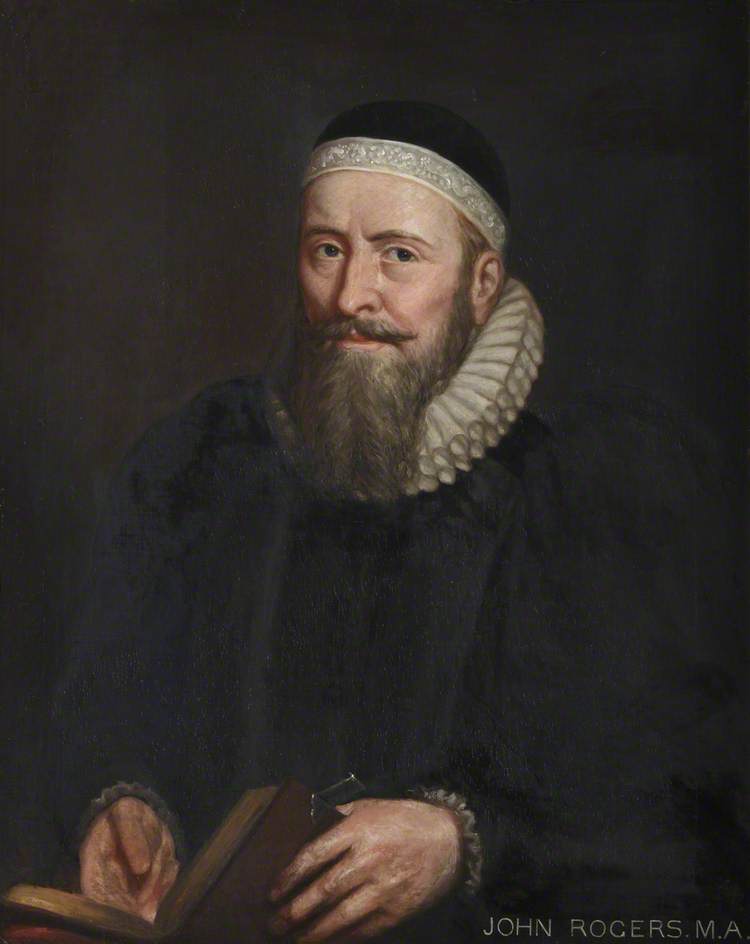
When Rogers returned to England in 1548, he became a prebendary of St Paul's. When Queen Mary Tudor came to the throne, Rogers preached against "pestilent Popery, idolatry and superstition”. He became one of many Protestants rounded up and imprisoned for their beliefs. He spent a year in Newgate prison and then was bought to trial by Bishop Gardiner.
His trial was held in the retrochoir of St Saviour's Church (now Southwark Cathedral). In January 1555, he was given the death sentence for denying the Christian character of the Church of Rome. Before his execution, he was told that he would be pardoned if he retracted his previous statements but he refused.
Rogers was burned at the stake at Smithfield on 4 February 1555. He is considered to be the first martyr of Queen Mary Tudor’s reign.
Saint Swithun (800 – 862)
Swithun was the Anglo-Saxon Bishop of Winchester from 852 until 862. It is believed that Swithun set up a college of priests in Southwark, hence his association with the history of Southwark Cathedral. 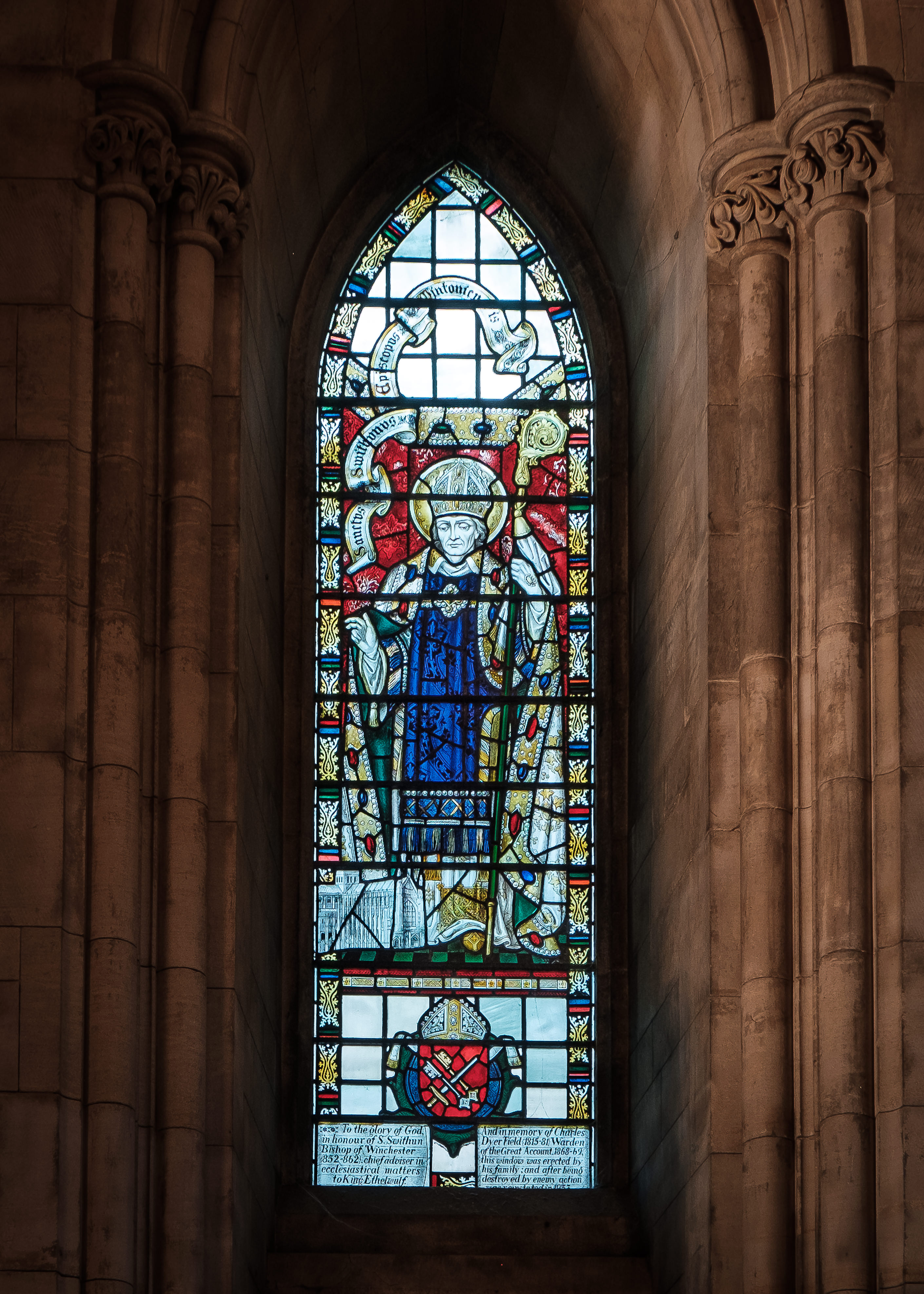
There is no evidence that this happened. However, when he became Bishop of Winchester he was known for his enthusiasm in building new churches or restoring old ones. As the site of Southwark Cathedral was part of the Diocese of Winchester within its history, it is possible that a connection was made between Swithun’s settling of new churches, and his association with Winchester and Southwark.
During his life time Swithun was a modest man and requested that Æthelwulf the Anglo-Saxon king gave a tenth of his royal land to the Church. When he died, he was buried in the churchyard at Winchester and is the patron saint of Winchester Cathedral.
In the Screen he can be seen holding a bridge which he built over the River Itchen.
St Thomas Becket (1119 – 1170)
Thomas Becket was born in London to a merchant family of Norman origins. From the age of ten he was sent to Merton Abbey; he had some schooling but a change in family fortunes led him to clerical work which eventually led to a position serving Theobald of Bec, the Archbishop of Canterbury.
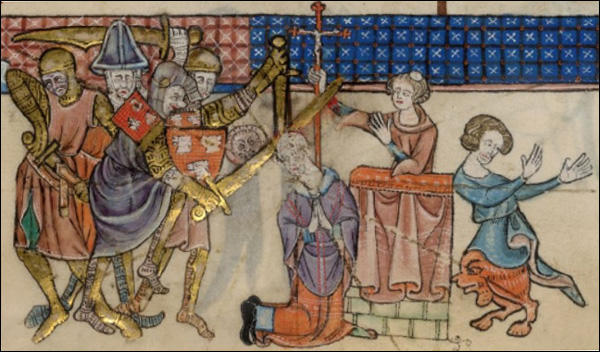 He was sent on several missions to Rome and studied canon law. In 1154, he became Archdeacon of Canterbury and in the following year King Henry II appointed him as his Chancellor whose job it was to enforce the traditional sources of revenue extracted from all landowners including the church.
He was sent on several missions to Rome and studied canon law. In 1154, he became Archdeacon of Canterbury and in the following year King Henry II appointed him as his Chancellor whose job it was to enforce the traditional sources of revenue extracted from all landowners including the church.
Becket was elected to the position of Archbishop of Canterbury in 1162 after the death of Archbishop Theobald. King Henry hoped that the new Archbishop would continue to put the royal government first. However, as Becket’s beliefs became more ascetic, he resigned as Chancellor and sought to recover and extend the rights of the archbishopric.
A series of conflicts with the King led to exile on the continent under the protection of Louis VII of France. In June 1170, the heir apparent, Henry was crowned by three bishops which breached Canterbury’s privilege of coronation. Becket excommunicated all three clergymen who fled to Normandy where King Henry was residing.
A meeting between Becket and Henry in July 1170 resulted in reconciliation. However, Becket refused to absolve his fellow bishops from their part in supporting Henry. This enraged the King and it is thought that he issued a royal command for the murder of Becket. On 29 December 1170, four knights assassinated Becket at his Cathedral in Canterbury.
From this point, miracles, associated with Becket, were proclaimed; on 21 February 1173, Becket was canonized by Alexander III. A shrine was built at Canterbury and this became one of the principal pilgrimage centres of Christendom until it was destroyed by Henry VIII in 1538.
The canons of St Mary Overie (the church we now know as Southwark Cathedral) built a hospital dedicated to St Thomas of Canterbury and from Southwark the pilgrimage route to his shrine in Canterbury began.
St Margaret of Antioch (289-304)
St Margaret (also called St Marina) was a popular saint in the church.
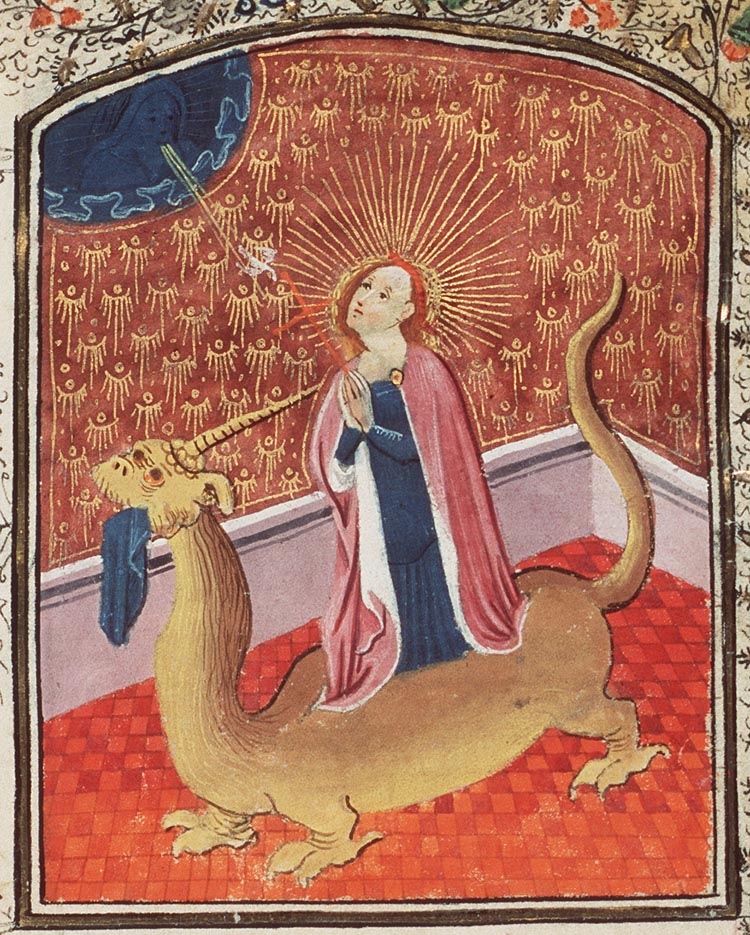
According to legend, she was the daughter of a pagan priest but nursed by a Christian woman whose faith she adopted. Olybrius, a powerful Roman Governor, asked Margaret to marry her as long as she renounced her Christianity. She refused and was tortured. During this time she met the dragon who was the Devil in disguise. According to the legend, the dragon swallowed her but the cross she carried scratched his throat and he expelled her back out of his mouth. This is perhaps why she is associated with childbirth. She was put to death in 304.
In medieval England, over 250 churches were dedicated to her. One of these churches was in Southwark, located near Borough Market. During the Reformation, St Mary Overie (the church that was to become Southwark Cathedral) became the church for the old parish of St Margaret’s. In 1555, St Margaret’s Church was disposed of, with tenements being built on the churchyard and the church being used as a courthouse. The building burnt down in 1676 and any memory of St Margaret’s is retained in street names
Saint Peter (? – 64)
Peter, also known as Simon Peter, was a Galilean fisherman called by Jesus to become a follower. He was one of the twelve apostles and the first to recognise Jesus as the Messiah.
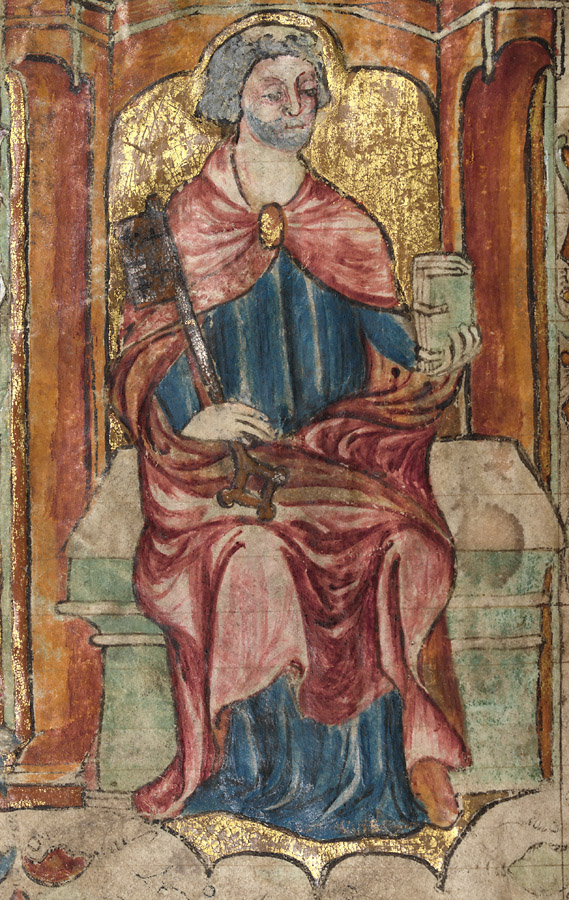 Peter was a faithful disciple although at the Last Supper Jesus predicted that Peter would deny him three times. At the time of the arrest of Jesus, Peter cut off the ear of a servant of the high priest with a sword but then, as had been predicted, he denied three times that he had ever known Jesus.
Peter was a faithful disciple although at the Last Supper Jesus predicted that Peter would deny him three times. At the time of the arrest of Jesus, Peter cut off the ear of a servant of the high priest with a sword but then, as had been predicted, he denied three times that he had ever known Jesus.
Peter delivered a significant sermon at Pentecost and travelled to spread the Gospel. He is thought to have founded the early church in Rome with Paul and is considered to be the first Pope. In Matthew’s Gospel, Jesus said to Peter ‘You are Peter (rock) and on this rock I will build my Church’.
It was in Rome in 63/64AD that the Roman Emperor Nero set fire to the city and blamed the Christians for its destruction. Peter was one of the Christians who was taken prisoner and was sentenced to death by crucifixion. He was crucified on Vatican Hill with his head downwards because he did not consider himself worthy to die in the same manner and posture as Jesus.
St Peter is represented in the Great Screen of Southwark Cathedral as the first builder of churches as well as one of the twelve apostles and also his place as one of the Patrons of the Diocese of Winchester. His symbol, the keys, is intertwined with the symbol of the other patron, St Paul.
Our Lady (with infant Jesus)
The Blessed Virgin Mary, the mother of Jesus, takes a central role in this screen as the original building on this site was a priory dedicated to her. Known as St Mary Overie (meaning over the river), the religious settlement on this site existed from 1106 to 1538 before the church became known as St Saviour’s.
St John the Evangelist
St John is considered to be the writer of the fourth gospel and a disciple of Jesus. He had been a fisherman working with his brother James before he became a follower of John the Baptist and then a follower of Jesus.
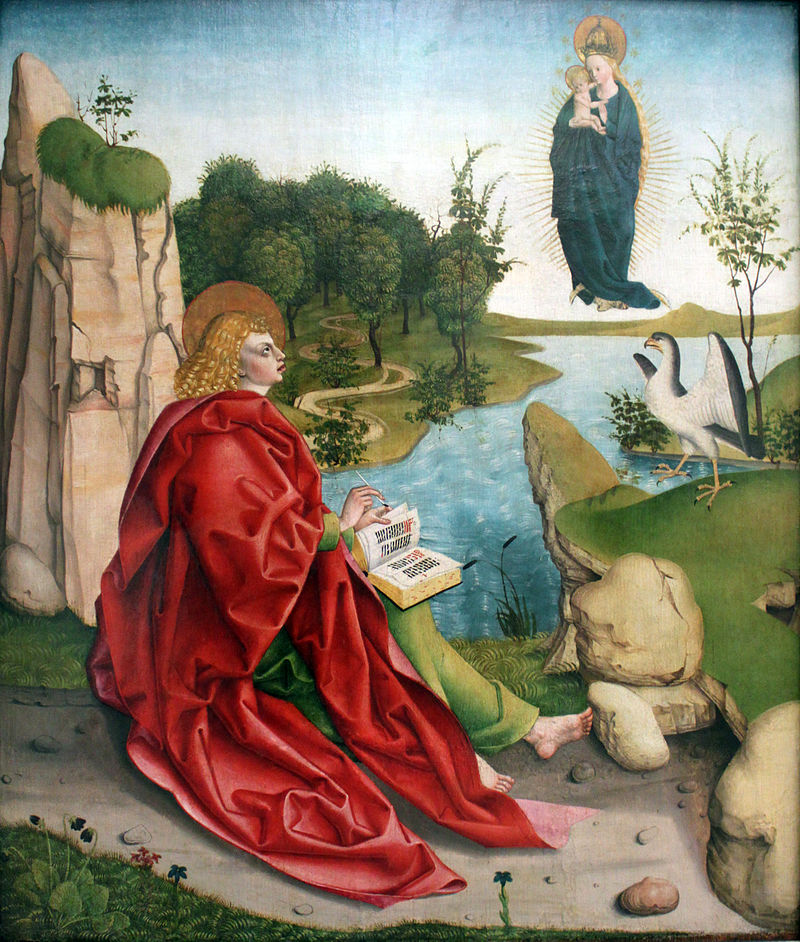 St John had a prominent role, along with St Peter, in founding of the early church. He worked in Jerusalem and at Ephesus preaching the ministry of Jesus and was responsible for the conversion of many people to Christianity. He lived to an old age and died of natural causes.
St John had a prominent role, along with St Peter, in founding of the early church. He worked in Jerusalem and at Ephesus preaching the ministry of Jesus and was responsible for the conversion of many people to Christianity. He lived to an old age and died of natural causes.
The Harvard Chapel, off the north choir aisle of Southwark Cathedral, was originally dedicated to St John the Evangelist.
St Mary Magdalene
She was a follower of Jesus who was present at his crucifixion. Along with Mary, the mother of James, and Salome, another follower of Jesus, they discovered the empty tomb. 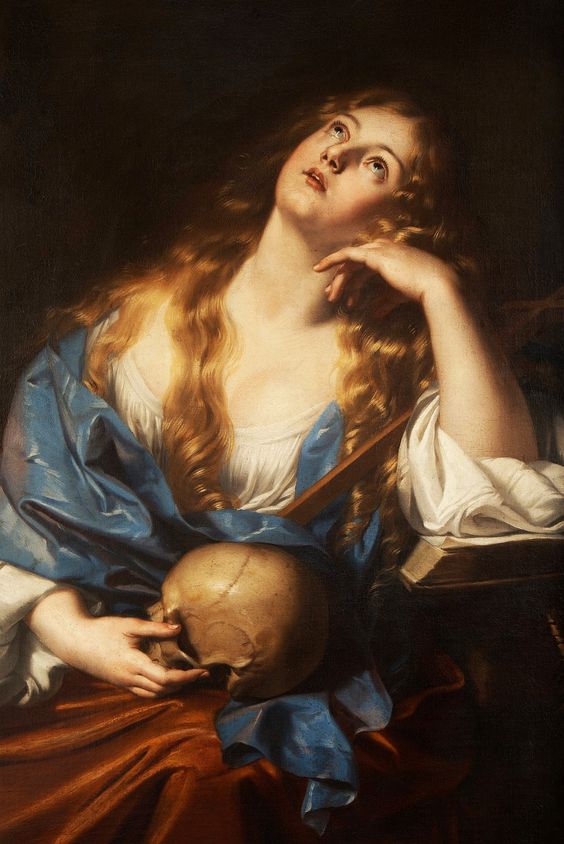
In the gospels of Mark, Matthew and John, Mary Magdalene is the first to witness the Resurrection and the appearance of the Risen Christ. She is included in the Great Screen as the chapel that once served as a parish church, which occupied the space now filled by the organ pipes, was dedicated to St Mary Magdalene.
John Gower (1327 -1408)
John Gower was an early-English poet and good friend of Chaucer. He spent the later years of his life living at the priory of St Mary Overie, Southwark, the building we now know as Southwark Cathedral. He is buried in an elaborate canopied tomb which can be found in the north aisle.
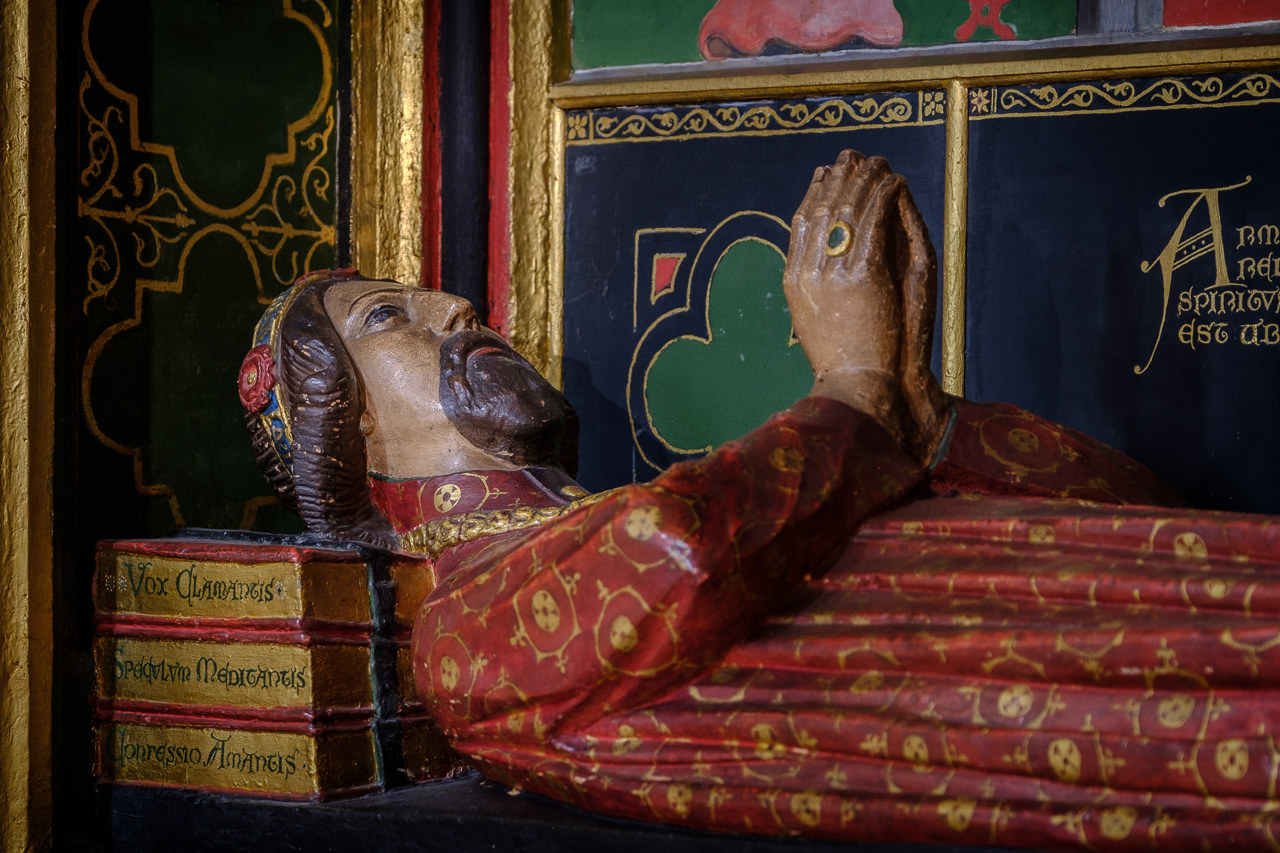 Little is known of Gower’s early life. It has been suggested that he might have been a lawyer and he did have incomes from estates. Gower was probably a court official and had been acquainted with both Richard II and Henry IV. From the 1370s, he lived at the priory in Southwark.
Little is known of Gower’s early life. It has been suggested that he might have been a lawyer and he did have incomes from estates. Gower was probably a court official and had been acquainted with both Richard II and Henry IV. From the 1370s, he lived at the priory in Southwark.
He is remembered primarily for three major works, the Speculum Meditantis, Vox Clamantis, and Confessio Amantis, three long poems written in French, Latin, and English. Apart from his work, Gower is known for his friendship with Chaucer. When Gower died in 1408 much of his wealth went to the priory. His tomb in the Cathedral is one of the remaining medieval monuments on site.
Peter des Roches (? – 1238)
Peter des Roches, a native of France, became Lord Chamberlain at the end of the reign of Richard I. He was elected Bishop of Winchester in 1205 having been Archdeacon at Poitiers and Precentor of the Diocese of Lincoln. 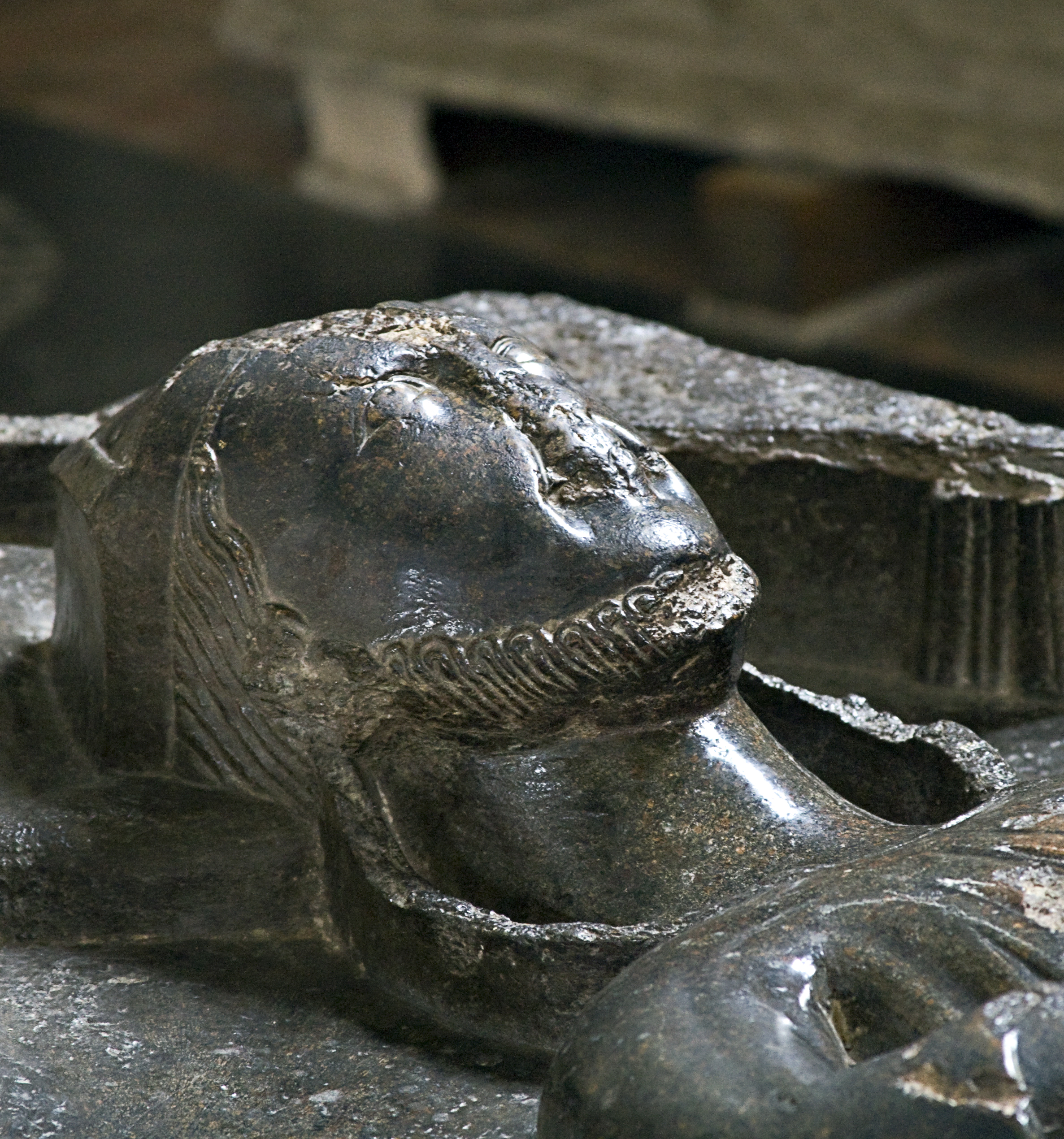
Winchester bishops had lands in Southwark and it was des Roches who was Bishop in 1212 when a great fire swept through the area. The fire badly damaged the priory church of St Mary Overie (what we now know as Southwark Cathedral) as well as the adjoining hospital of St Thomas Beckett
Des Roches is said to have arranged for the rebuilding of the priory of St Mary Overie including adding the chapel to St Mary Magdalene which served the local parish. He modernised the churche by rebuilding in the Gothic style with pointed arches rather than round ones. He also carried out major work on Winchester Palace which is recorded in the Pipe Rolls for the Diocese of Winchester.
Des Roches also founded several monasteries in England and France including Titchfield Abbey and Netley Abbey in Hampshire and La Clarte-Dieu in Poitou, France.
Randall Davidson (1848-1930)
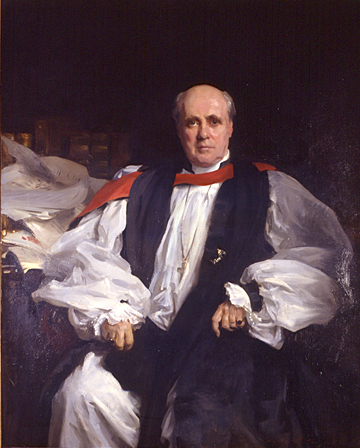 Randall Davidson was Bishop of Rochester between 1891 and 1895. It was in this role that he carried on the work, started by the previous bishop, Anthony Thorold, which would establish a separate diocese in Southwark. He also supervised the erection of the Bishop’s House at Kennington Park in one of the most densely populated areas of the Diocese. This house was eventually to be the first home of the new Bishop of Southwark in 1905.
Randall Davidson was Bishop of Rochester between 1891 and 1895. It was in this role that he carried on the work, started by the previous bishop, Anthony Thorold, which would establish a separate diocese in Southwark. He also supervised the erection of the Bishop’s House at Kennington Park in one of the most densely populated areas of the Diocese. This house was eventually to be the first home of the new Bishop of Southwark in 1905.
In 1895, he became the Bishop of Winchester and, in 1903, the Archbishop of Canterbury, an office he held until 1928 when he retired.
Bottom Row
Beneath
Henry I (1068-1135)
Henry I was king at the time of the founding of the Priory in 1106.
Henry was the fourth son of William the Conqueror. He ascended the throne in 1100. William Giffard, who some consider to have been involved in the founding of the priory at Southwark, was Lord Chancellor of England for Henry. The King had a major role in choosing who should be bishops and archbishops and tended to give the jobs to his officials. This was the likely reason that Giffard became Bishop of Winchester.
Lancelot Andrewes (1555 – 1626)
Lancelot Andrewes is the only Bishop of Winchester to be buried in Southwark Cathedral although at the time of his death it would have been known as St Saviour’s, the local parish church. Born in 1555, he was baptised at All Hallows–by-the–Tower in which parish he was probably born. He was educated at Merchant Taylors’ School and then went onto Pembroke College, Cambridge
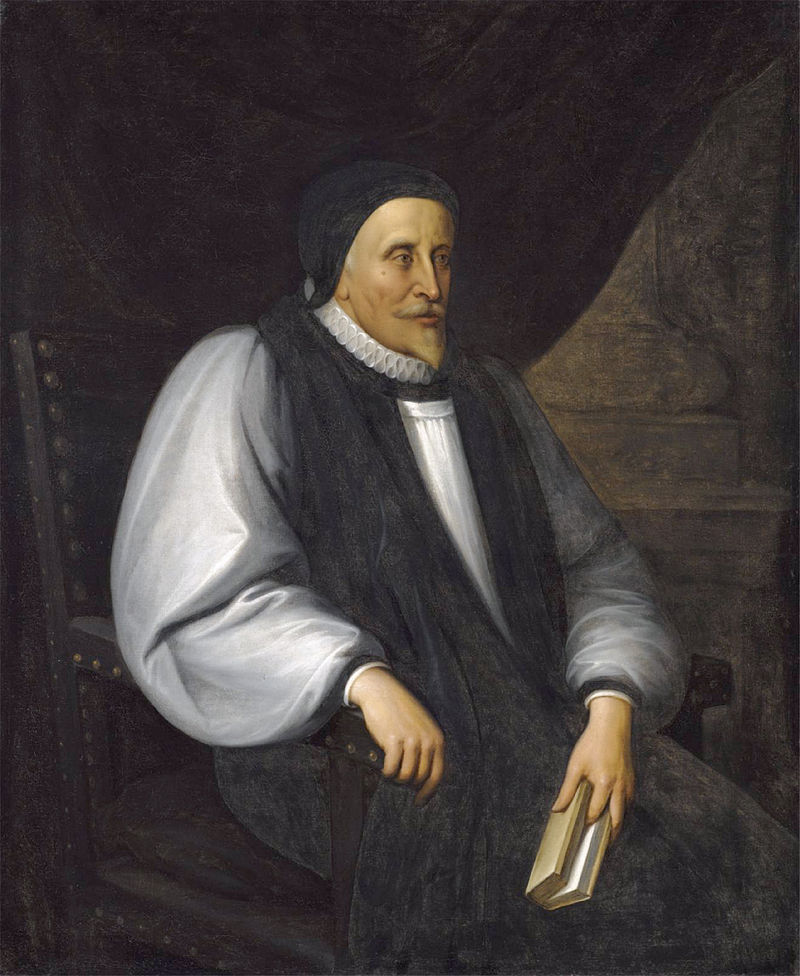 He became Master of Pembroke and subsequently Bishop of Chichester, Bishop of Ely and then Bishop of Winchester in 1619. He was also a Prelate to the Order of the Garter and the last episcopal resident of Winchester House which was conveniently situated for his Privy Council duties.
He became Master of Pembroke and subsequently Bishop of Chichester, Bishop of Ely and then Bishop of Winchester in 1619. He was also a Prelate to the Order of the Garter and the last episcopal resident of Winchester House which was conveniently situated for his Privy Council duties.
Described as a brilliant scholar and linguist and also an able administrator, Andrewes was commissioned to be part of the team that provided the translation for the Authorised Version of the Bible also known as the King James Bible. He is personally credited for his translation of the Pentateuch – the first five books of the Bible in the Old Testament (Genesis, Exodus, Leviticus, Numbers and Deuteronomy).
His tomb can be found to the right of the Great Screen.
Bishop Richard Fox (1448 – 1528)
The first thirty-five years of Fox’s life are unclear although it is believed that he went to both Oxford and Cambridge. He came into contact with Henry Tudor – the future Henry VII – and was taken into his service. This eventually led him to be escalated into powerful positions at Court and in the Church. In 1501, he became the Bishop of Winchester and this would have bought him to the priory of St Mary Overie.
Edward VII (1841 – 1910) 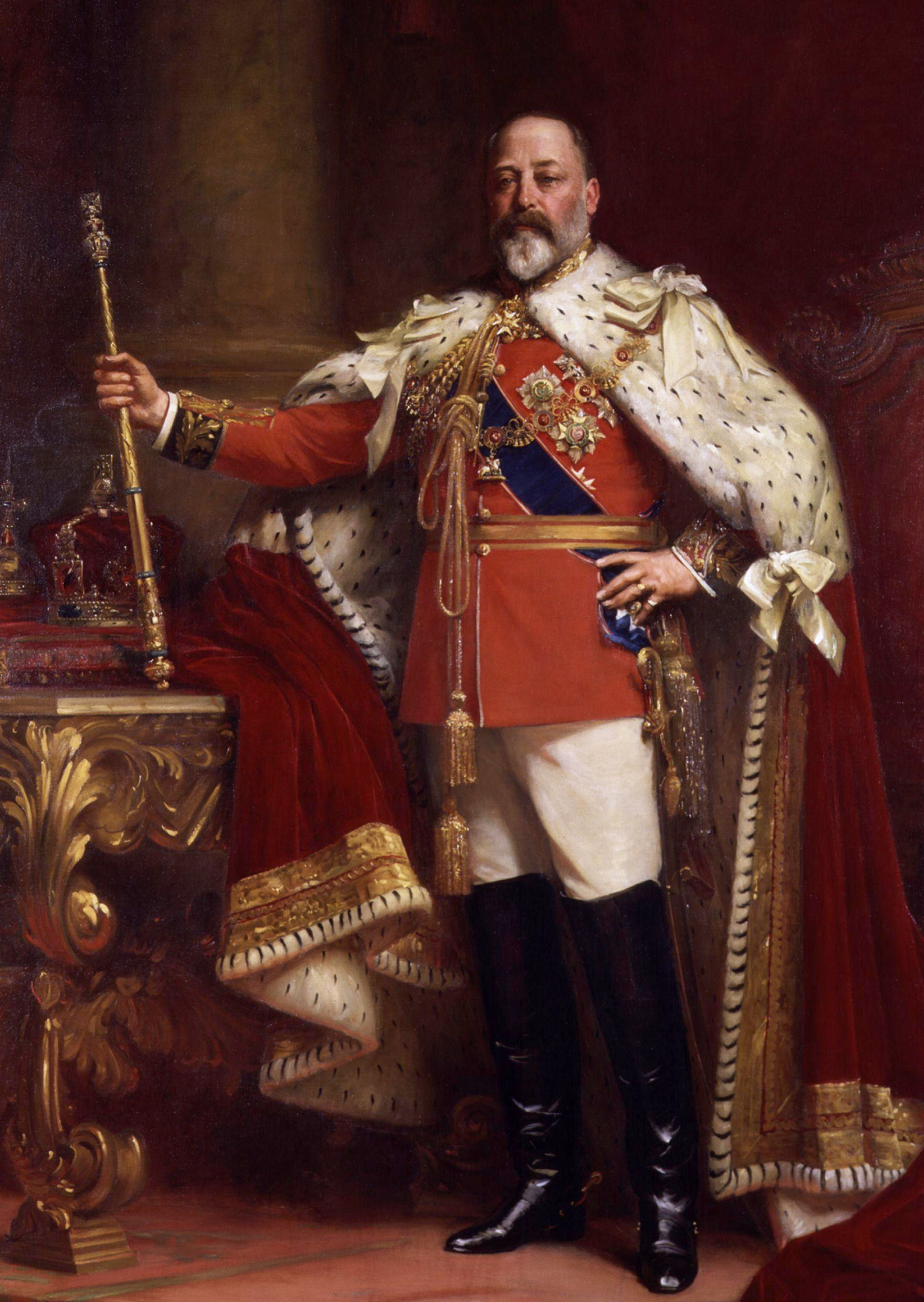
The final statue at the bottom of the screen is to King Edward VII who was king at the time of the dedication of the church as a Cathedral. It was he who laid the foundation stone for the rebuilding of the nave and was present at the Inauguration. This statue was unveiled in 1915 by his widow, Queen Alexandra.
The lower stage of the Screen was coloured and gilded by J.N. Comper in 1929.
Altar Piece - The Risen Christ
Immediately above the High Altar, an altar piece designed by Sir Ninian Comper in 1929 was inserted.
The central figure is the Risen Lord, and near Him are the symbols of the Four Evangelists. To the left are the figures of the Four Latin Fathers, St. Jerome, St. Gregory the Great, St. Ambrose and St. Augustine of Hippo, and to the right those of the Four Greek Fathers, St. Gregory of Nazianzum, St. Athanasius, St. Basil and St. Chrysostom. Also included are four angels holding the arms of the Province of Canterbury, the Diocese of Rochester, the Diocese of Winchester and the Diocese of Southwark.
The small figures above represent the twelve Apostles and were designed by Mr Oldrid Scott and made by Messrs Farmer and Brindley.
